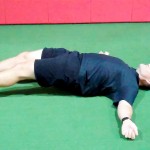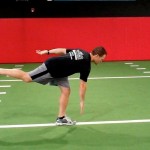Brian Schiff’s Blog
Injury Prevention, Sports Rehab & Performance Training Expert
As we age, balance steadily declines. This exercise is an effective and fun way to challenge balance and increase lower body strength. I typically incorporate it for clients dealing with patellofemoral knee pain, glute and hip dysfunction as well as anyone struggling with dynamic limb stability. Watch the video below and give it a try yourself!
One of the great things about being a columnist for PFP Magazine is that I often get to test out the latest fitness equipment on the market. While there are certainly some very gimmicky things out there, I have some ‘go to’ selections in my toolbox, such as the BOSU®NexGen™Pro Balance Trainer. It is the latest version of this training tool.
In my clinic, I rehab lots of athletes suffering from gluteus medius weakness, poor pillar stability and decreased hip stability. Many of my clientele are working to make it back from ACL reconstruction. One of my preferred strengthening exercises to target the shoulder, torso and hips is split squats. Once the client masters proper form on the ground, I move to an unstable setting using the BOSU®.
It is essential to challenge athletes to avoid valgus collapse. The BOSU® introduces instability at the ankle forcing the body to adapt during the split squat movement. Avoiding dynamic valgus and trunk dominance during training will help with injury reduction efforts for the client.
In the video below I produced for my PFP online column, you will see how to use this exercise effectively to improve strength, stability and proprioception.
One of the biggest challenges for clients overcoming knee injuries and surgery is regaining their quadriceps strength and fighting atrophy. This is increasingly so for my clientele on crutches for any extended period of time. It is paramount to use modalities early on in the rehab process such as electrical stimulation and blood flow restriction training to combat atrophy and loss of strength.
Once appropriate, I always move to single limb training to eliminate imbalance and asymmetry. While pistol squats are one of the most effective single leg quadriceps exercises, not all clients can perform this movement. So, in many cases I opt to use a single leg box squat (see video below).
For more information on specific progressions and regressions, click here to read my entire online column. Keep in mind that you should never force through any painful range of motion as this likely indicates excessive strain on the patellofemoral joint.
Many athletes and clients struggle with hamstring muscle activation. A normal quad to hamstring ratio would be 3:2, but studies often find that subjects tend to be closer to 2:1 (especially females). This diminished ratio can increase knee injury risk (non-contact ACL) with jumping and cutting sports. Some people struggle with proximal hamstring tendinopathy related to overuse. Incorporating eccentric hamstring exercises in your training can markedly improve hamstring strength and activation patterns.

Quad/Ham dynamic relationship
Execution: Begin in supine with 90 degrees of knee flexion and the feet flat on the floor. Next, bridge up into a table top position. Then, slowly begin to walk the feet out keeping the weight on the heels in an alternating pattern. Move the feet as far away from the body as possible while maintaining a good static bridge position.
Once form starts to falter or fatigue sets in, walk the feet back in using the same cadence and incremental steps until the start position is achieved. Perform 5 repetitions and repeat 2-3 times. Focus on control while avoiding pelvic rotation, and be cautious working into too much knee extension to avoid poor form or cramping.
This is an excellent way to improve hamstring strength while emphasizing pelvic stability. This exercise should be preceded by static bridging to ensure the client understands how to maintain a neutral pelvic position (consider using a half roll or towel as a visual aid to cue him/her out of rotational movement initially). The walk out exercise can be implemented as part of ACL prevention/rehab programs and also works well for runners and athletes struggling with hip/pelvic stability, proximal tendinopathy and general posterior chain weakness.
Regression: Bridge up and march in place for repetitions or time to develop sufficient strength and stability.
Progression: Increase repetitions or slow the cadence down pausing longer at each step to increase time under tension. Additionally, move the hands from palm down to palm up to reduce stability. For advanced clientele, the arms could be crossed with the hands resting on the opposite shoulder.
Perhaps one of the most researched topics is ACL injuries. I have been studying and working for years in my clinical practice to find the best ways to rehab athletes following injury as well as implement the most effective injury prevention strategies. Prior studies indicate prevention programs even when self directed can be successful.
However, on the whole injury rates have not declined over the past decade or so. Much attention has been given to valgus landing mechanics, poor muscle firing, stiff landings, genetic difference between males and females, ligament dominance, quad dominance, and so forth. The predominant thoughts today for prevention center around neuromuscular training and eliminating faulty movement patterns (refer to work being done by Timothy Hewett and Darin Padua).
We also know from a biomechanical standpoint that the hamstrings play an integral role in preventing excess anterior tibial translation, and as such hamstring strengthening needs to be a big part of the rehab and prevention program. I believe in hamstring training that allows for activation in non-weaightbearing and weight bearing positions. Common exercises I will use include:
- HS bridging patterns (double /single leg, marching, knee extension, stability ball)
- Nordic HS curls
- HS curls (stability ball, TRX or machine)
- Sliders – focus on slow eccentric motion moving into knee extension followed by simultaneous curls/bridge
- Single leg RDL (add dumbbells or kettle bells for more load)
Note: click on any of the thumbnail images above for a full view of the exercise. From left to right: Nordic HS curls, sliding hamstring curls and single leg RDL).
A recent blog post entry by the UNC Department of Exercise and Sport Science (@UNCEXSS) has spurred my post today. Click here to read their entry on optimizing injury prevention based on work done by Professor Troy Blackburn regarding the effect of isometric and isotonic training on hamstring stiffness and ACL loading mechanisms. The research that was done holds promise for hamstring training designed to increased musculotendinous stiffness (MTS).




